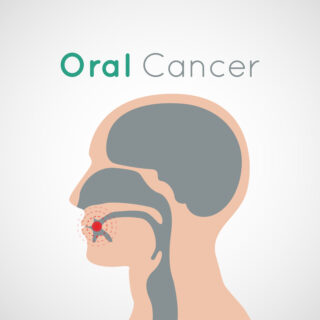
Northern Virginia Surgical Arts
611 South Carlin Springs Road
Suite #308
Arlington, VA 22204
Northern Virginia Surgical Arts
7230 Heritage Village Plaza
Suite #101
Gainesville, VA 20155
Northern Virginia Surgical Arts
9110 Railroad Drive
Suite #100
Manassas Park, VA 20111
Northern Virginia Surgical Arts
361 Walker Drive
Suite #202
Warrenton, VA 20186
OPENING SOON! Northern Virginia Surgical Arts
9001 Digges Road
Suite #102
Manassas, VA 20110

More Dental Health Articles
Oral Cancer: Symptoms and Risk Factors

When it comes to the lining of the mouth, there is a special type of skin (mucosa) that is coral pink in color and smooth in texture. Changes in color or texture may indicate a warning sign for a pathological process such as oral cancer.
The following can signal a pre-cancerous or cancerous growth:
- Reddish patches (erythroplakia) or whitish patches (leukoplakia) in the mouth
- A sore that doesn’t heal and bleeds easily
- A lump or thickening on the skin lining inside of the mouth
- Chronic sore throat or hoarseness (difficulty chewing or swallowing)
These changes can also be noticed on the lips, cheeks, palate, and gum tissue around the teeth, tongue, face, and/or neck. Pain isn’t always associated with oral pathology. If you experience facial or oral pain with no obvious reason, you should seek medical attention immediately.
Routine oral cancer screenings by your dental professional are highly recommended.
Regular screenings are especially important to people who are at a higher risk for oral cancer. Knowing your risk factors and talking about them with your doctor may help you make more informed lifestyle and health care choices.
The risk of oral and oropharyngeal cancer is greatly increased by two factors:
Tobacco use. Using tobacco, including cigarettes, cigars, pipes, chewing tobacco, and snuff, is the single largest risk factor for head and neck cancer. 85% of head and neck cancer is linked to tobacco use.
Alcohol. Frequent and heavy consumption of alcohol increases the risk of head and neck cancer. Using alcohol and tobacco together increases this risk even more.
Other factors that can raise a person’s risk include:
- Prolonged sun exposure
- Human papillomavirus (HPV)
- Gender – men are more likely to develop than women.
- Fair skin
- Age – people older than 45 have an increased risk for oral cancer.
- Poor oral hygiene/diet/nutrition
- Weakened immune system
Other Articles You May Find of Interest...
- Appliances Are In Now: How To Manage TMJ Disorder
- Why The Tooth Fairy Is Very Fun – and Important!
- Let’s Smile Dental’s 7&Up Club
- Strengthening Smiles: Understanding the Importance of Splinting Periodontally Involved Teeth
- Understanding Soft Tissue Grafting: A Key To Periodontal Health
- New Solutions for Dentures and Dental Implants
- How New Tech In the Dental Office Benefits You

















